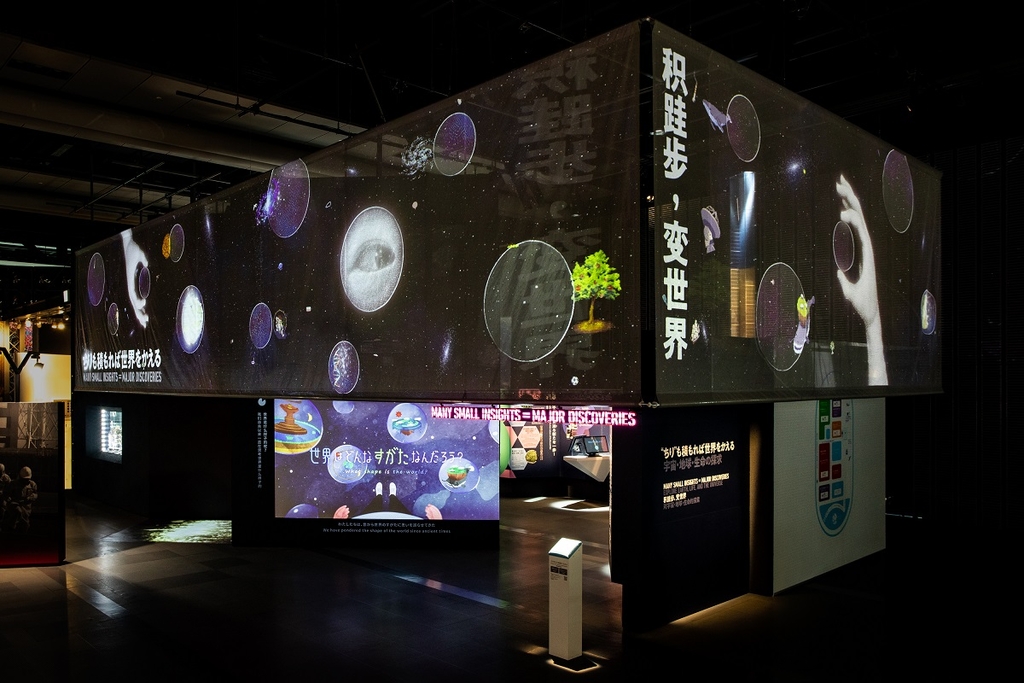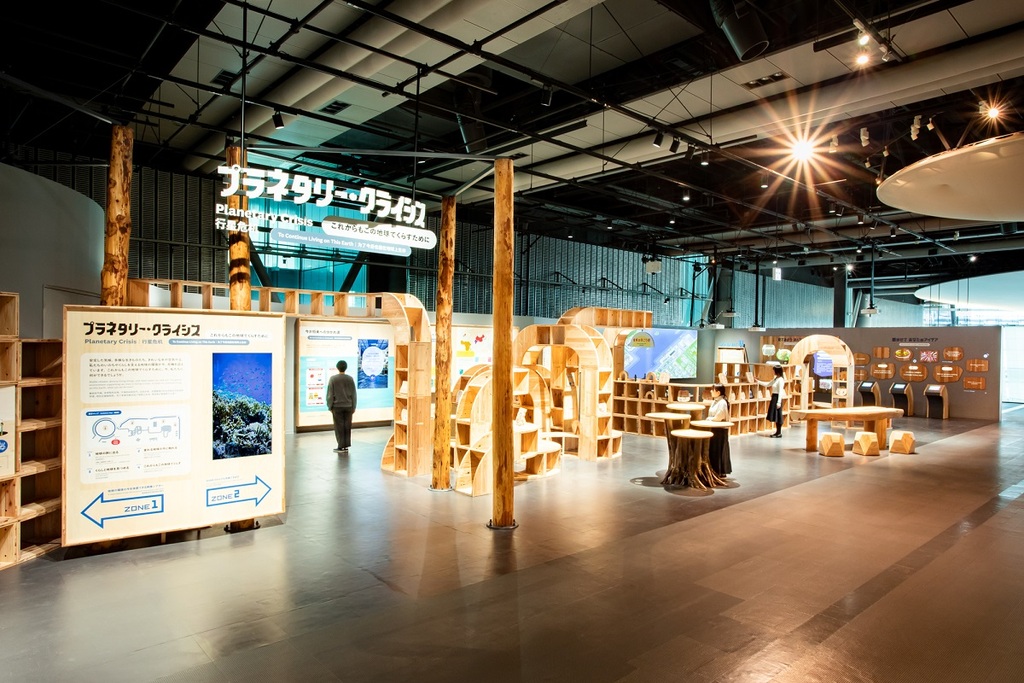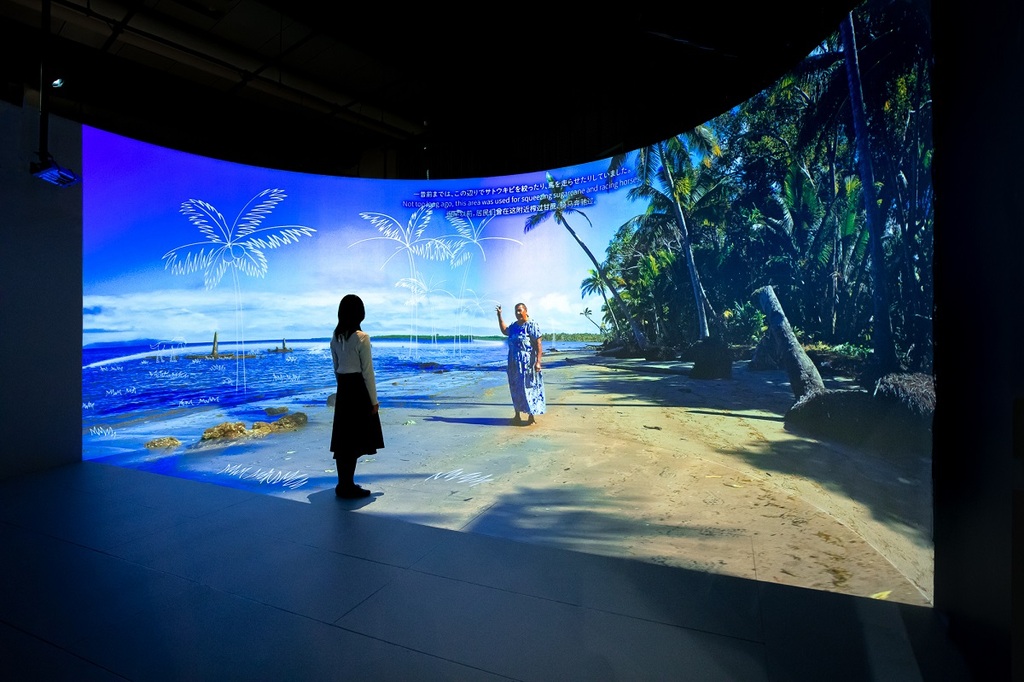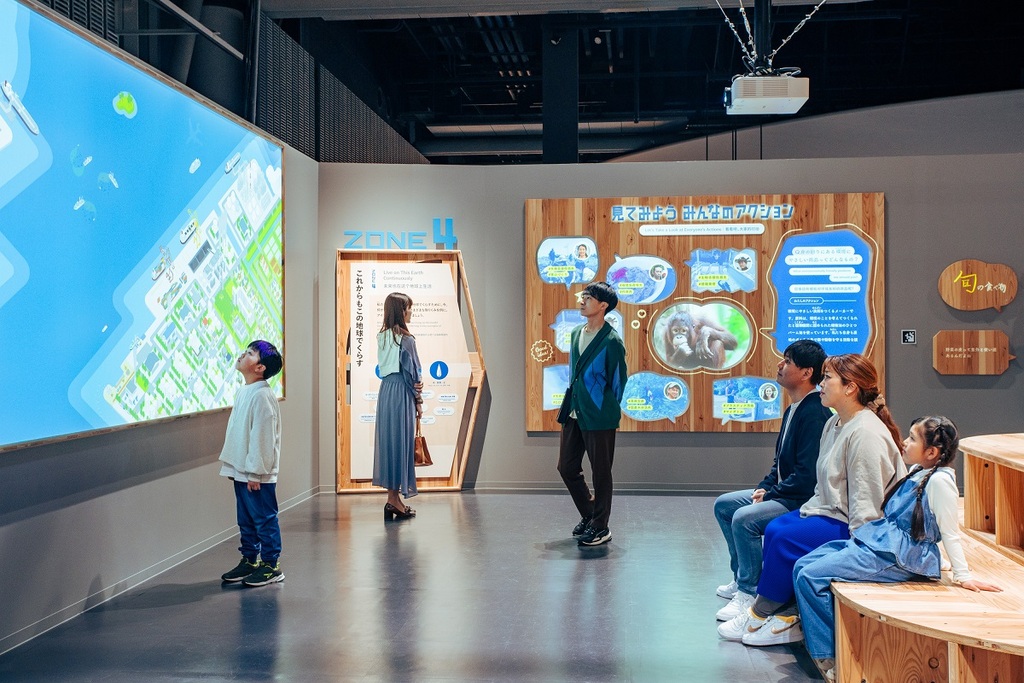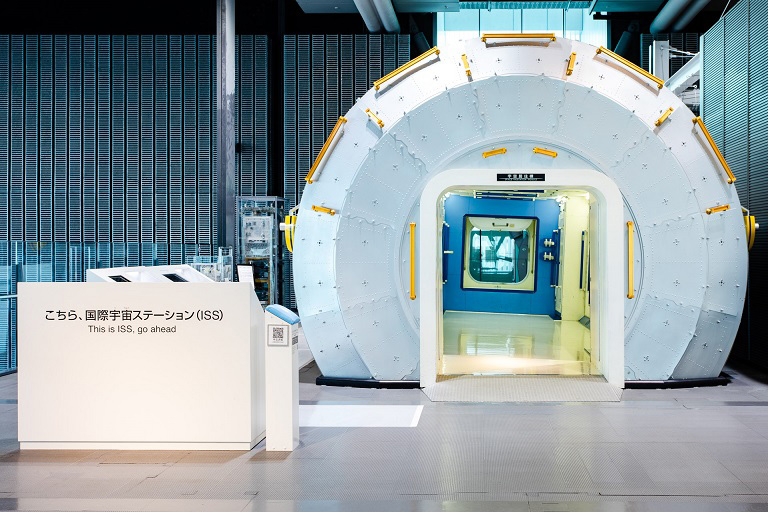
Outline of exhibition
What can we do now to continue living on this Earth? We’ll take a multifaceted look at the global environment and our daily lifestyles, and explore positive steps we can take to help create a better future.
As we touch on a range of initiatives that could help us continue living on this Earth, we hope you will reflect on your own lifestyle going forward.
- Location
- 5F (Explore the frontiers)
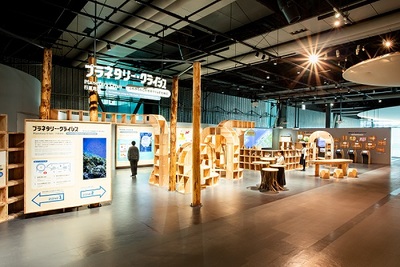
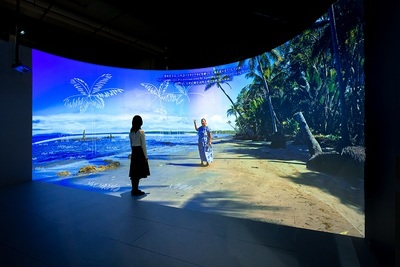
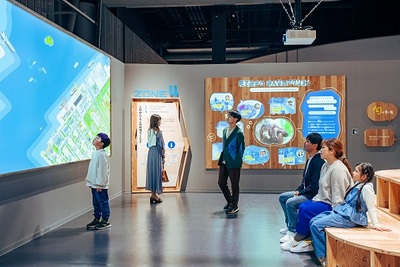
Weather refers to the state of the constantly changing atmosphere—such as sunny skies or rainy days, fluctuations in temperature—while climate generally refers to the long-term averages of weather over time. For example, a certain area might experience different weather during the same period in different years, but, by taking the averages, those variations disappear, and the most likely weather can be determined. The “average” in the “average temperature” or “above-average rain” of weather forecasts is usually based on an average taken over at least the past 30 years. Just as the heat of the same summer will differ between north and south, the climate is also influenced by latitude, terrain, ocean currents, and other factors. The problem is that the climate is currently changing at a speed never before experienced by human.
We know that in Japan about 7,000 years ago, during the Jomon period, the sea level rose and later fell. This phenomenon is known as the Jomon transgression, and the evidence of this has been found in many areas including inland shell mounds. The major cause of the sea level rise at this time was that the peak of the glacial period passed about 20,000 years ago, and huge ice sheets that covered the land in the Northern Hemisphere melted, causing an increase in seawater. At its highest level during the Jomon period, the sea rose more than 100 meters. Sea levels later fell—but this was not because it became cold enough for ice sheets to form again. It was actually caused by the weight of seawater putting pressure on the mantle, the deformable layer beneath the ocean floor, and pushing it toward land, thereby pushing the landmass up from below. This was an unusual phenomenon that did not occur in the same way over the rest of the world.
The Earth simultaneously absorbs the energy poured into it by the sun and releases energy (infrared radiation) back into space. As energy is released, part of that energy is absorbed by water vapor, carbon dioxide, and other elements in the atmosphere, and returned back to the planet's surface. This action is called the “greenhouse effect.” It has been calculated that the Earth's surface would be an average of about -19 degrees Celsius without the greenhouse effect, but it is about +15 degrees Celsius in reality. It is the greenhouse effect that maintains an environment suitable for life on Earth. At present, however, as a result of increased levels of carbon dioxide and other elements emitted by human activities, the greenhouse effect has grown too strong, causing a rapid increase in temperatures. On a related note, on Venus, which has an atmosphere consisting primarily of carbon dioxide, the greenhouse effect is so strong that the surface of the planet reaches around 460 degrees Celsius!
Gases that absorb energy heading back to outer space and heat up the Earth's surface are called greenhouse gases, and there are many such gases in the atmosphere. The one with the strongest greenhouse effect is water vapor, but water vapor is something that increases or decreases depending on temperature, and changes in water vapor volume are not directly linked to human activities. In order to halt the current changes to the climate, it is essential to eliminate emissions of carbon dioxide, as it is the second strongest greenhouse effect after water vapor. In addition, the methane emitted from livestock burps, the dinitrogen monoxide emitted when chemical fertilizers are used , and the chlorofluorocarbons used in factories have significant greenhouse effects, and efforts are being made internationally to reduce these emissions. Conversely, many of the fine particles formed in the transformation of exhaust or volcanic gases, though not gases themselves, are known to cool the Earth's surface by blocking the sun's energy.
It is said that humans started emitting high levels of carbon dioxide around 200 years ago, from the time of the Industrial Revolution. This happened due to the invention of the steam engine and other machines that used coal as fuel, leading to the use of large amounts of fossil fuels as a source of energy. It was also partly due to deforestation to create farmland and residential areas as the population increased (when trees are cut down, they gradually emit carbon dioxide as they decompose). However, the most rapid increase in emissions has actually occurred within the past few decades. According to estimates by the Intergovernmental Panel on Climate Change (IPCC), there were cumulative global emissions of 2.4 trillion tons of carbon dioxide from 1850 to 2019, but 62% of that amount was emitted after 1970, and 42% was emitted after 1990. Initiatives to reduce emissions are currently underway worldwide, but at the same time the global population is growing and economic activity continues to expand, so emission amounts have not yet begun to decline.
Just as a cup does not overflow even if the ice floating in it melts, sea levels will not rise even if the ice floating at the Arctic Sea melts. However, if ice melts in the Himalayan mountains, Greenland, Antarctica, and other areas on land, this will put more water into the ocean, causing sea levels to rise. Over the past 100 years or so, the global average sea level has risen about 20 centimeters, and the melting of glaciers on land (excluding those in Greenland and Antarctica) into the sea is responsible for 41% of this rise in sea level. The volume of water also increases when it is heated, and this thermal expansion accounts for 38% of the rise in sea level. Though not understood in detail, it is said that sea levels would rise by seven meters if all the ice in Greenland melts, and that Antarctica has enough ice to cause a 60-meter increase in sea level. Some of this ice has started to melt. Scientists are watching to see what will happen to this ice in the future, because that will determine how much global sea levels rise.
There are two primary drivers of climate change. The first is natural phenomena like volcanic eruptions and changes in solar activity, and the second is carbon dioxide and other elements released by humans burning fossil fuels. Researchers worldwide looking at these drivers have created simulations on supercomputers that follow the laws of physics, and discovered that the observed temperature increases from 1850 to 2019 cannot be explained without including factors attributable to human activities. In its 2021 report, the Intergovernmental Panel on Climate Change (IPCC) concluded that “It is unequivocal that human influence has warmed the atmosphere, ocean and land.” In addition, Dr. Syukuro Manabe, a senior researcher at Princeton University in the U.S., has been using calculations to study how an increase in carbon dioxide changes the climate since the 1960s, when climate change was still not attracting attention. His work led to him winning the Nobel Prize in Physics in 2021.
As climate change advances, it is projected that the impacts of extreme heat, heavy rains, and other extreme weather events will grow increasingly severe. However, at present it is difficult to imagine in any real sense what the impacts will be in the far future. To try to get an idea, a research team from the National Institute for Environmental Studies and other institutions compared the differences in the number of extreme weather events experienced by a “grandparent generation” born in 1960 and a “grandchild generation” born in 2020, based on forecast data, assuming that both generations will have a lifespan of 80 years. Assuming a high level of greenhouse gas emissions, they saw that, in Japan, the grandchild generation would experience 400 extreme heats and 3 heavy rains more than their grandparents had. On the other hand, if greenhouse gas emissions could be significantly reduced, these numbers could be brought down to 20 extreme heats and 2 heavy rains. Climate change countermeasures need to take into account not only those of us living today, but also future generations.
The frequency and severity of extreme heat, heavy rain, and most of the other effects of climate change are projected to increase as temperatures rise. However, if we surpass the stage where these kinds of small-step increases are happening, it is possible that large, irreversible changes will occur. This turning point is called the “tipping point.” If temperatures pass a certain level, the Antarctic ice will begin a large-scale collapse, which could raise sea levels by as much as two meters by 2100. We could also see the tropical rainforests begin to dry out, and global ocean currents come to a halt. There's a lot that we don't yet know scientifically, but, as research progresses, it is necessary that we halt the increase in temperature before it passes those tipping points.
The global average temperature has increased by more than 1 degree Celsius due to climate change. While the international community is reducing greenhouse gas emissions to limit the increase in temperature as much as possible, even if we immediately reduce emissions, there will be an increase in temperature to some extent, and it is unavoidable that we will see further negative impacts. Various measures are needed to prevent or reduce the adverse effects of rising temperatures, such as raising levees to counter increases in sea level, promoting anti-heat stroke measures to prepare for extreme heat, and developing crops that can withstand high temperatures. Such measures are called “adaptations.” In some cases, the effects of climate change can be harnessed to good effect, such as by starting to grow crops in areas that could previously not support them. However, even as we push forward with such adaptations, there are limits to what we can achieve. It is essential that we simultaneously reduce greenhouse gas emissions and limit increases in temperature before the damage becomes unmanageable.
The possibility that increased levels of carbon dioxide might raise temperatures was pointed out by researchers around the world in the second half of the 19th century. One person inspired by this theory was the author Kenji Miyazawa. In Miyazawa's 1932 story “The Life of Budori Gusuko,” a man that purposely cause a volcano to erupt, forcing it to release carbon dioxide in order to raise temperatures and save farmers suffering from cold-weather damage (today we know that volcanic eruptions are actually quite effective in lowering temperatures). However, it actually wasn't until about 100 years later that the need to lower carbon dioxide levels became known. In the latter half of the 20th century, it was actually confirmed that the concentration of carbon dioxide in the atmosphere was rising, and a series of extreme weather events heightened the sense of urgency among researchers globally. This led the United Nations and other organizations to create the Intergovernmental Panel on Climate Change (IPCC) in 1988 to compile the latest research findings. In 1992, an international treaty, the United Nations Framework Convention on Climate Change, was established to encourage countries to take actions.
Looking back over the past two million years of Earth's history, we can see that there was a repeated cycle of approximately 100,000 year-long cold climates (glacial periods) and warm climates (interglacial periods). During glacial periods, the land masses in the northern hemisphere were covered with vast expanses of ice. It has been explained that these long-term changes in temperature and other factors are triggered by changes in the amount of solar radiation received by the Earth due to variations in distance between the Earth and the Sun and other cyclic changes on 100,000-years scale (known as the Milankovitch cycle). In the change from the last glacial period, which ended about 12,000 years ago, to the current interglacial period, it took 5,000 years to raise the temperature by about 5 degrees Celsius. The temperature then began slowly falling, but due to climate change caused by current human activity, that trend has reversed, with temperatures rising about 1.1 degrees Celsius over the past 150 years. Temperatures might fall if a glacial period comes again, but the next glacial period, if it ever comes, is expected to be another 50,000 years later.
Cherry blossoms bloom, cicadas begin to sing, and many living things, animals and plants alike, react to changes in temperature. We know that the timings of things like these are being altered by climate change. According to the Japan Meteorological Agency, cherry blossom bloom dates in the spring have been shifting 1.2 days earlier per decade, and maple leaf color changes in the fall have been happening 3.0 days later per decade. Also, each living thing has its own preferred temperature range, so when the climate changes and it becomes hotter, they gradually shift their habitats to cooler latitudes or higher elevations. However, most livings things are limited in how far they can move. If the current rapid pace of change continues, it may not be possible for most of them to keep up. The higher temperatures rise, the higher the possibilities are that a wide range of species will go extinct.
Living things in the ocean are also shifting their habitats in response to rising sea temperatures and other factors. In addition, like the extreme heat we're seeing on land, “marine heatwaves” are also increasing in the oceans, with sudden increases in temperature spanning several days or longer, weakening coral and killing off some schools of fish in affected areas. There is also concern about the impacts of ocean acidification. The increased carbon dioxide in the atmosphere is being absorbed by the oceans, making the oceans more acidic (ocean water is slightly alkaline, and makes it close to neutral). This has an impact on, for example, organisms with a calcium carbonate shell, like shellfish, coral, and plankton, because it becomes more difficult for them to make that shell. It has also become clear that the amount of oxygen dissolved in seawater, on the other hand, is gradually decreasing over a wide area, with concerning effects. It is possible that the amount of fish we can take from the oceans will continue to shrink in the future.
We know that the overall amount of carbon dioxide that humans have put into the atmosphere from the past up to now is roughly proportional to a certain increase in temperature. That is to say, regardless of what the temperature will be, to stop raising temperature we must halt carbon dioxide emissions. Since it won't be easy to completely zero out emissions, we could instead try to achieve net emissions of zero by removing carbon dioxide from the atmosphere—an approach known as “carbon neutrality.” One major example method for trying to remove carbon dioxide is by increasing the amount of forestland. This works because carbon dioxide is absorbed during photosynthesis. Other methods are also being promoted, including the development of technologies to directly remove carbon dioxide from the atmosphere. To limit the rise in temperature to the 1.5 degrees Celsius mark that the global community is aiming for, the planet overall must achieve carbon neutrality in the latter half of this century.
Some of you may have heard about the COP international conference in the news. The United Nations Framework Convention on Climate Change conference is often referred to as the COP (Conference of the Parties). The Kyoto Protocol was established under this agreement at the third COP held in Kyoto in 1997. Based on the idea that developed countries, which became rich by emitting more greenhouse gases early on, have a heavier responsibility, the first requirements for emission reductions were imposed on developed countries. Japan's target—a 6% reduction from 1990 levels for the 2008-2012 period—has already been achieved. However, emissions from developing countries have also increased, making it impossible for developed countries alone to stop climate change. Under the Paris Agreement, reached at COP21 in 2015, all countries have been tasked with reducing emissions. Using 2013 as a baseline, Japan aims to achieve a 46% reduction in emissions by 2030, with a challenge target of 50%. However, since each country decides on its own how much to reduce emissions, it is not yet clear whether the rise in temperatures can be halted.
The legs and tops of two tables on the hallway side of the exhibition area are made from oak trees with intricate branches and two-pronged cypress trees. These unusual wood shapes, which are rarely used, were effectively utilized as materials for the exhibition.
Trees are produced and used in our daily lives in a sustainable cycle of planting, growing, logging, and re-planting. In this exhibition space, we deliberately used unprocessed logs and branches to remind visitors of the trees and forests that continue to be used in different forms.
The exhibition space is made up of "Tsumibako" wood blocks, which are intended to be reused after the exhibition. One "Tsumibako" can be used as a bookshelf, or multiple "Tsumibako" can be rearranged into different shapes. Before the exhibition opened, we held a workshop on the reuse of "Tsumibako". While getting hands-on with 1/7th-scale building blocks constructed from scraps of wood from the production process of the "Tsumibako", the participants, together, thought about potential future uses for the wood blocks.
Video footage: "Creating an Exhibition Together"
The wooden "Tsumibako" blocks are basically assembled from CLT (*1) panels using a mortise-and-tenon assembly (*2) and screws. The "Tsumibako" are connected to each other using only bolts, which allows for easy disassembly and reuse, both during and after the exhibition. A single "Tsumibako" can be used as a bookshelf, or multiple "Tsumibako" can be rearranged into different shapes.
*1 CLT: Cross-laminated timber (CLT) is lumber made by layering wooden boards so that their fiber direction is perpendicular to one another and then gluing them together. Orthogonal laminated boards. *2: Mortise-and-tenon assembly: A method of fixing wood in place by inserting a protruding section into a hollowed-out slot
The "Tsumibako" wooden blocks are manufactured using CLT (*1) made from cedar logged in central and southern Tottori Prefecture and processed within Tottori Prefecture.
If logged wood can be used for a long period of time in its lumber form as furniture, posts, etc., this will help with carbon dioxide fixation. In addition, in recent years, Japan's forest resources have been underutilized due to the growing use of timber from overseas. As a result, forest thinning and other management practices have not been sufficiently implemented, leading to landslides and other problems. Proper utilization of forest resources will also lead to a reduction of environmental burdens.
*1 CLT: Cross-laminated timber (CLT) is lumber made by layering wooden boards so that their fiber direction is perpendicular to one another and then gluing them together. Orthogonal laminated boards.
The five logs located near the entrance to the exhibition are from Hinohara Village, Tokyo, and the two tables on the hallway side of the exhibition area are made of wood from Hachioji City.
By purchasing locally grown timber directly from local forestry companies, the distance of timber transport can be shortened and carbon dioxide emissions from transit can be reduced. Appropriate thinning of the trees as they grow is also expected to promote healthy growth of the trees, absorb carbon dioxide, and help prevent landslides.
The "Tsumibako" wooden blocks were made by processing wood from Tottori Prefecture into CLT at a factory in Tottori, cutting out forms at factories in Shiga and Hiroshima Prefectures, and then assembling them at a factory in Osaka. The many "Tsumibako" were then transported to Miraikan, where they were connected together and installed in the exhibition space.
The transportation route was planned to be a fairly straight line from the production site to Miraikan in order to reduce the carbon dioxide emissions incurred during transport.
Video footage: "From Forest to Exhibition"
This exhibition makes effective use of scrap wood left over from the process of creating the "Tsumibako" wooden blocks. Scrap wood 3 cm thick was stacked and used as the table legs for "Behind the Dining Table" and as part of the entrance panels for each zone. The column panel on which the QR code for this article is pasted was also cut out from scrap wood. We worked to use as little wood as possible by arranging the necessary shapes in advance using digital data, purchasing only the required amount of lumber, and cutting out the needed shapes in an efficient way.
Permanent Exhibition | Explore the frontiers

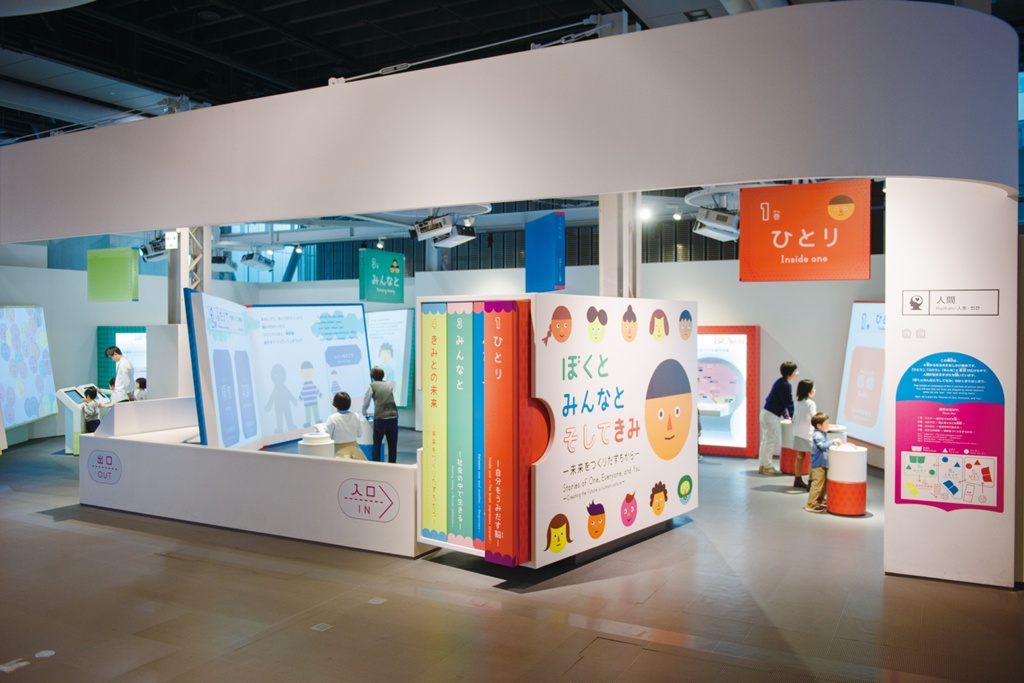
Stories of One, Everyone, and You
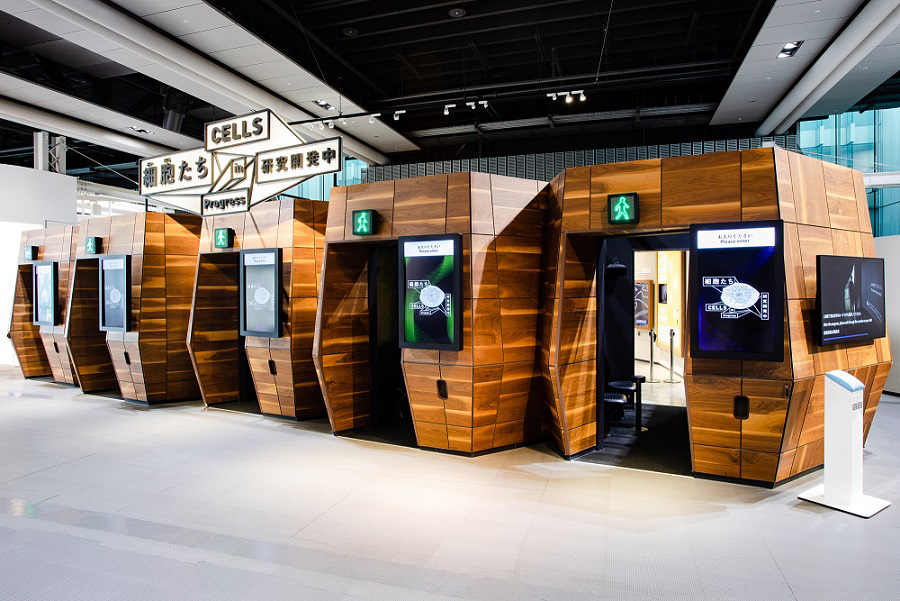
CELLS in Progress
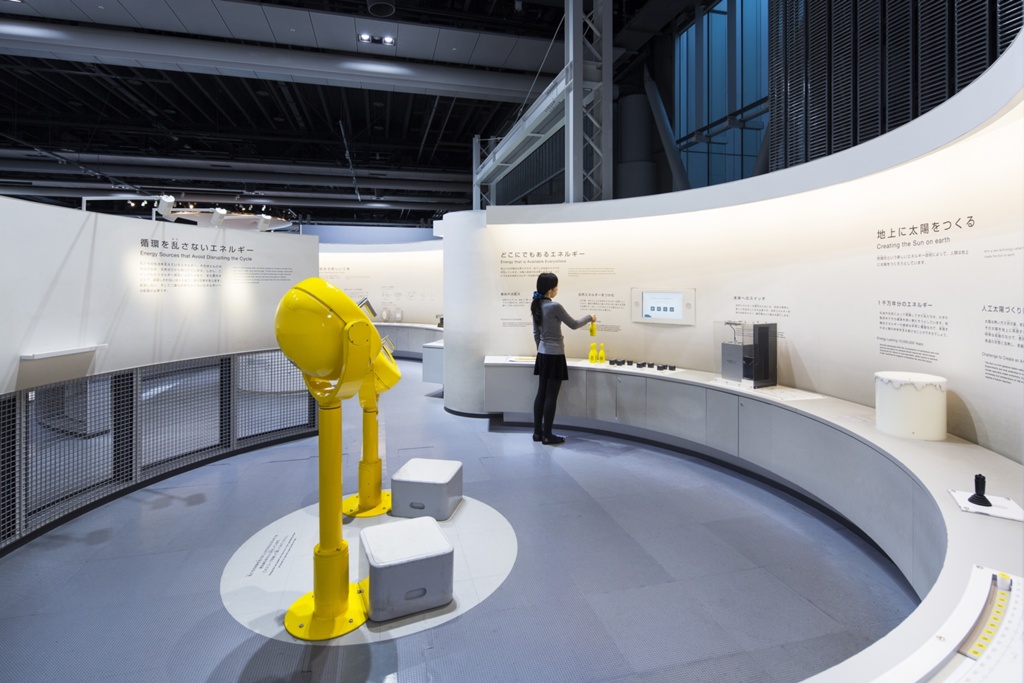
Earth Environment and Me
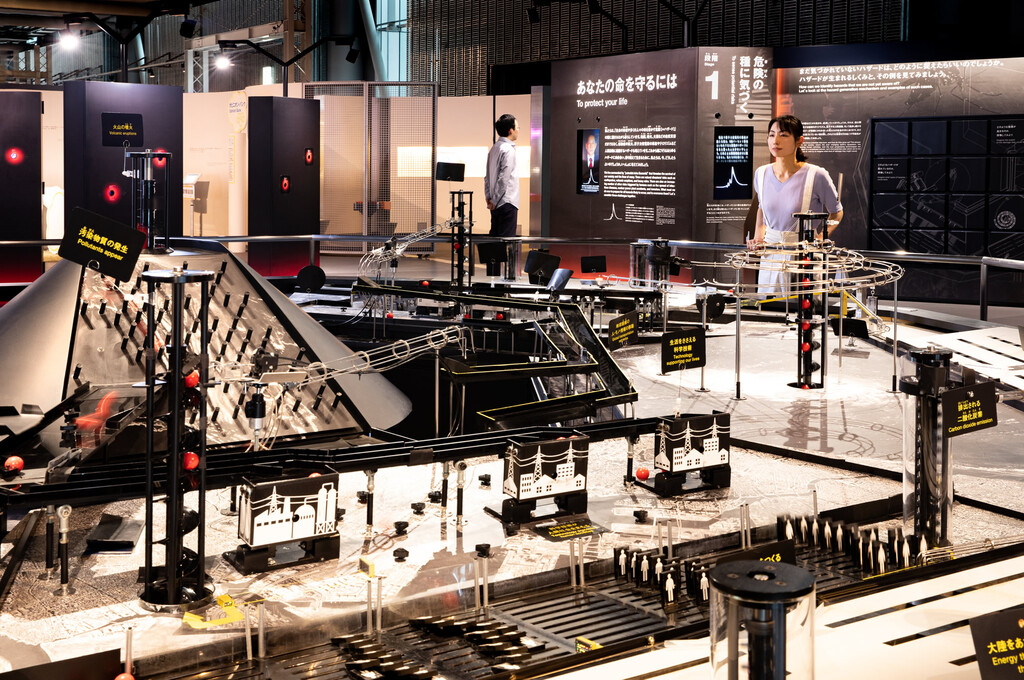
Mission Survival: 10 Billion
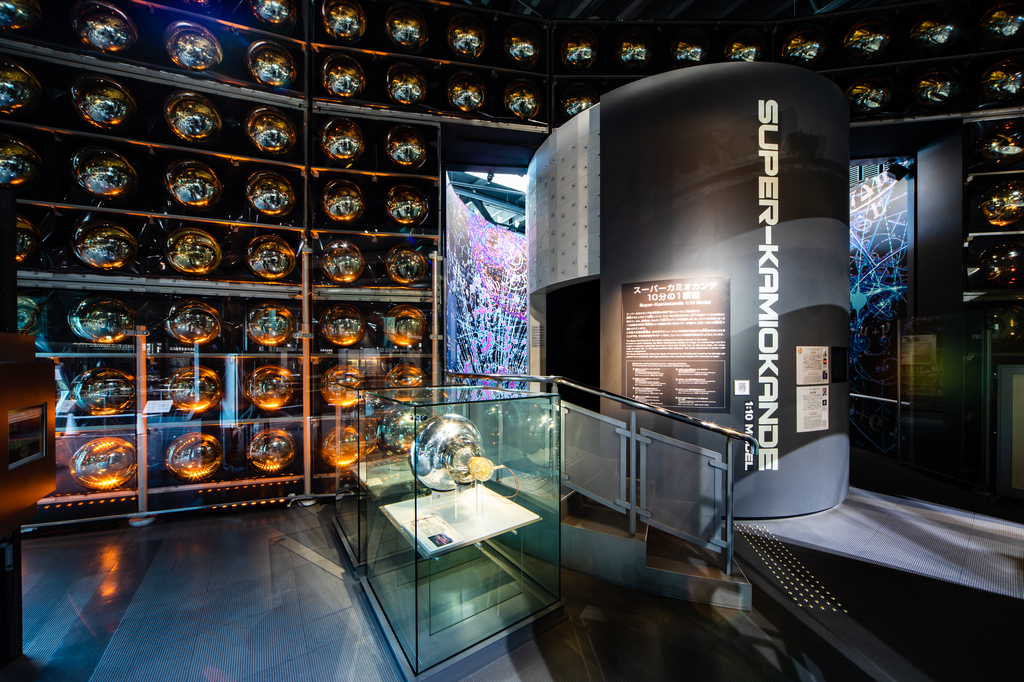
Understanding the Universe through Neutrinos
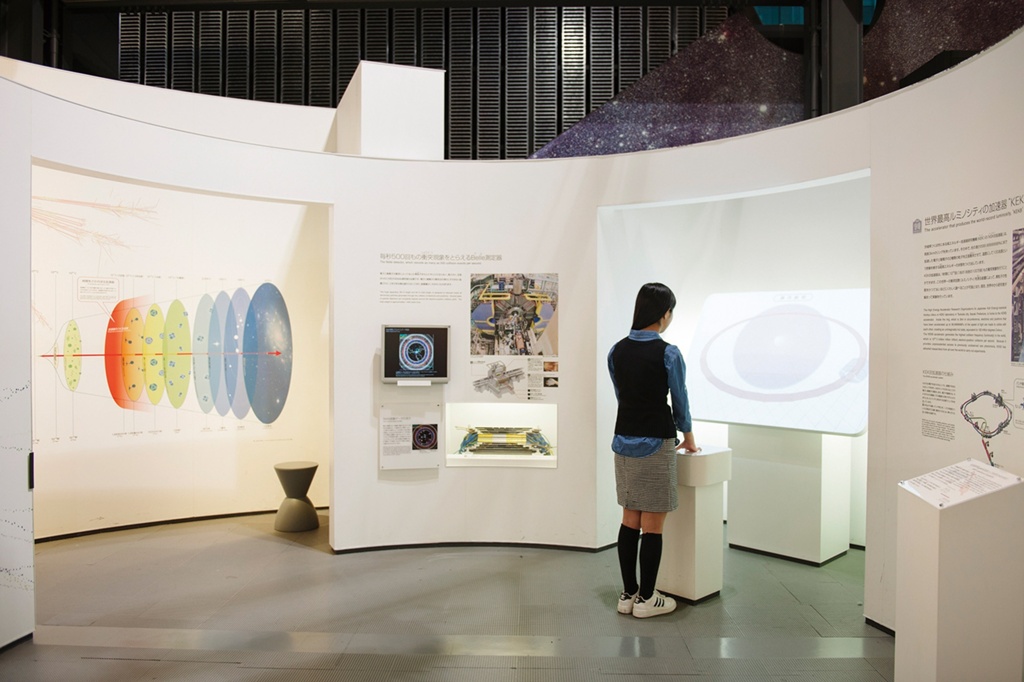
Study of Elementary Particles and the Universe with a Particle Accelerator
